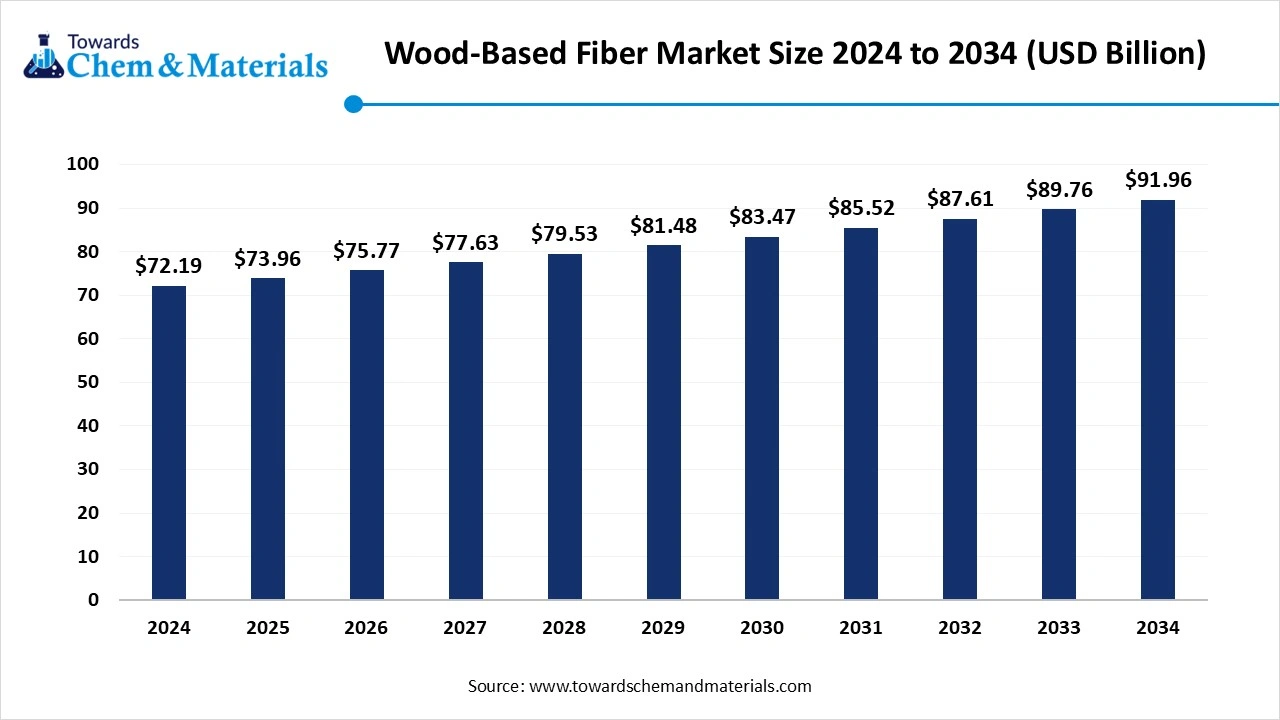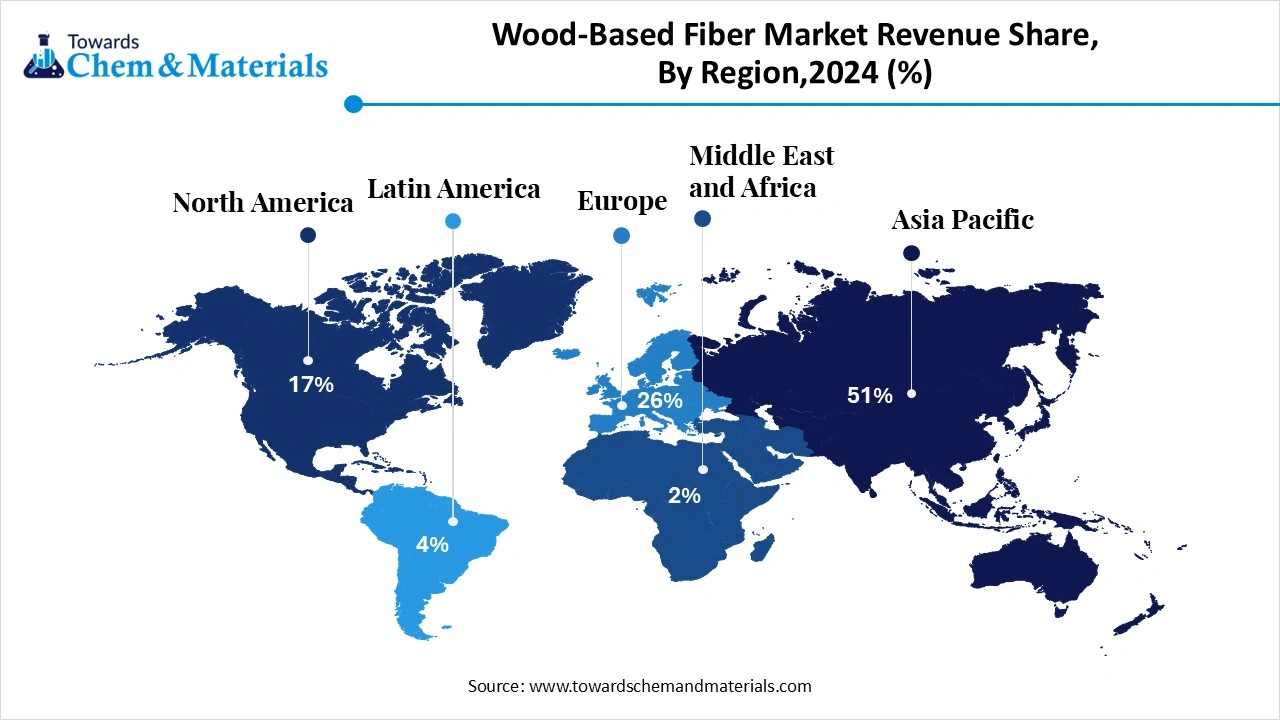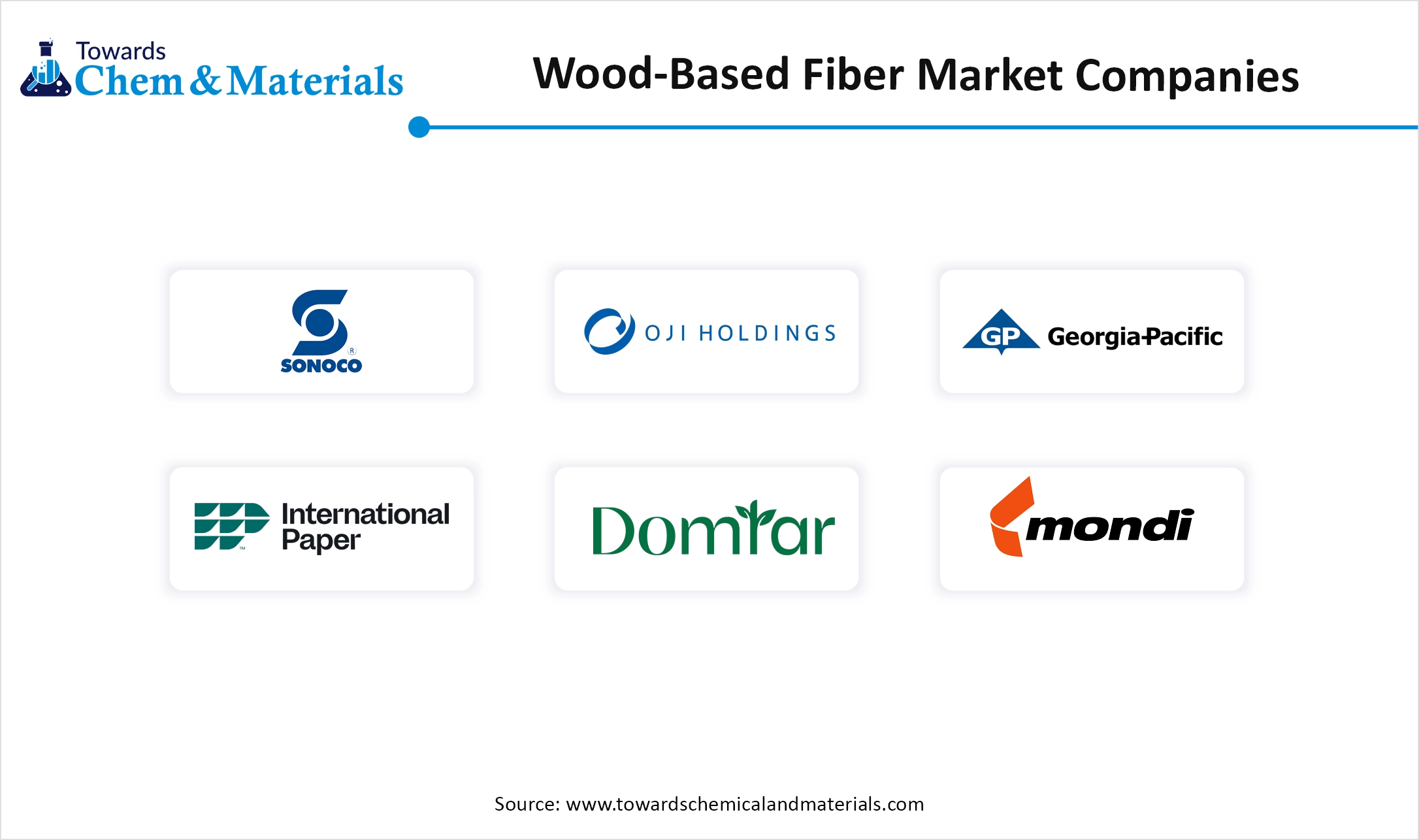April 2025
The global polysilicon market size was reached at USD 72.19 billion in 2024 and is expected to hit around USD 91.96 billion by 2034, exhibiting a compound annual growth rate (CAGR) of 2.45% during the forecast period 2025 to 2034. Rising demand from the textile industry and growing adoption of sustainable and eco-friendly alternatives to traditional materials drive the market growth.

Wood-based fibers are derived from trees and are utilized to manufacture materials such as textiles and paper. They are renewable resources generated from wood using specialized techniques like mechanical refining, chemical treatment, and heat treatment. Wood-based fibers are widely used due to their versatility, sustainability, and natural properties. They are the best alternative to traditional materials, and they are cost-effective.
They help to enhance qualities of other materials, like improving strength or increasing water retention in growing media. The ongoing technological innovations in wood-based fiber production to improve efficiency drive the market growth. Increasing environmental concerns and environmental regulations to promote the adoption of sustainable practices increase the demand for wood-based fibers. Rising utilization from various industries like textile, construction, and packaging contributes to the wood-based fiber market growth.
The growing urbanization increases the demand for residential, commercial, and infrastructural construction. The growing construction activities increase the demand for wood-based fiber due to their sustainability, versatility, and easy processing. These fibers are key components in different materials like wood-cement composite, medium-density fibreboard, and plywood. Plywood is widely used in construction due to its strength and versatility.
The growing environmental concerns give preference to renewable, natural, and biodegradable materials. Wood-based fibers are widely used in various building materials to improve load-bearing capacity, enhance sound insulation, and lower the carbon footprint.
Wood-based fibers like hardwood are widely used in flooring & furniture, panel products used in wall & roof sheathing, subflooring and interior panels, and hardboard used in interior applications, furniture, and doors. Constructors, builders, and consumers are giving preference to wood-based fibers due to factors like strength, durability, insulation properties, sustainability, and environmental benefits. The growing demand for an aesthetically pleasing look and a comfortable indoor environment is responsible for the market's growth. Rising construction activities are key drivers for the wood-based fiber market.
| Report Attributes | Details |
| Market Size in 2025 | USD 73.96 Billion |
| Expected Size in 2034 | USD 91.96 Billion |
| Growth Rate | CAGR of 2.45% from 2025 to 2034 |
| Base Year of Estimation | 2024 |
| Forecast Period | 2025-2034 |
| High Impact Region | Asia Pacific |
| Segment Covered | By Type, By Application, By Source, By End Use, By Region |
| Key Companies Profiled | Sonoco Products,Oji Holdings,Georgia-Pacific,International Paper,Domtar,Mondi,Sappi,KapStone Paper and Packaging, Canfor,Norbord,Smurfit Kappa,Razear,WestRock,UPM-Kymmene Oyj,Stora Enso |
The growing utilization of wood-based fibers in the textile industry is a key opportunity for market growth. A variety of garments and fabrics are created using wood-based fibers. The textile industry adopted wood-based fibers due to factors like sustainability and versatility.
They are the best alternative to traditional materials like cotton. The growing environmental issues increase the demand for fibers that require less water & land and have a lower carbon footprint. Wood-based fibers contain unique properties like softness, strength, and the ability to dye with vibrant colors.
They consist of better moisture management qualities; due to this, it is widely used in clothing and textiles. The waste produced during the manufacturing process is recycled or reused. The growing demand for wood-based fibers such as lyocell, viscose, and modal due to their comfort increases the demand for wood-based fibers.
The growing utilization of these fibers in home textiles, clothing, and nonwoven materials helps in market growth. The growing adoption of eco-friendly and sustainable textiles and innovations in technology creates a strong opportunity for the wood-based fiber market to grow.
Despite the growing expansion of wood-based fibers, high processing cost restrains market growth. Factors like the requirement of specialized chemicals, high energy consumption, and high initial investment in machinery increase the processing cost. The production of wood-based fibers requires extensive machinery and equipment for processes like refining, pulping, and others.
Manufacturing certain fibers like viscose requires particular chemicals that lead to higher costs. Other solvents, like iconic liquids used to reduce environmental impacts, are high-cost. The rising need for sustainable chemicals and techniques also increases production costs.
Fluctuation in fiber cost due to factors like sawmill residues, timber harvest, and rising demand from various sectors increases the overall cost. Furthermore, complex, intensive manufacturing process and environmental conditions leads to higher costs, and that hampers the wood-based fiber market growth.
Asia Pacific dominated the wood-based fiber market in 2024. The well-developed textile sectors and growing construction activities in the regions drive the market growth. The presence of a large population in the region increases the demand for wood-based products.
The availability of natural resources increases the manufacturing of various wood-based products. The growing urbanization and increasing disposable incomes raise the demand for furniture and construction materials, which drives the market growth.
The rising adoption of sustainable or eco-friendly fibers increases the demand for wood-based fibers. Furthermore, technological advancement in manufacturing contributes to market growth.
China is the largest contributor to the wood-based fiber market. The extensive economic growth increases the demand for wood-based products in various industries like pulp & paper production, construction, and furniture manufacturing, which fuels the market growth. The well-established wood-processing industry supports market growth. Furthermore, the growing adoption of sustainable materials and the strong presence of the textile manufacturing base further help in the market growth.

North America is growing at a significant rate in the market during the forecast period. The stringent environmental rules & regulations and sustainability initiatives from the corporate world drive the market growth. The well-developed textile industry in the region increases demand for wood-based fiber, like lyocell fiber.
The growing demand from various industrial sectors like nonwovens and construction, drives the growth of the market. The growing consumer adoption of biodegradable and renewable materials in personal care products, apparel, and home textiles increases the demand for wood-based fibers. Stringent environmental regulations and advancements in fiber processing technology fuel the market growth. Furthermore, the presence of key industry players in the region supports market growth.
The United States holds the largest share of the wood-based fiber market. The well-established forest lands and high supply of wood pulp drive the market growth. The extensive construction sector and rising adoption of sustainable and eco-friendly products increase the demand for wood-based fiber. The growing applications in various industries like paper, textile, packaging, and many more are fueling the market growth.
Europe is expected to grow at a notable rate in the wood-based fiber market during the predicted timeframe. The growing adoption of wood-based fibers in the textile industry fuels the market growth. The growing businesses and consumer adoption of sustainable practices increase demand for wood-based fibers. The stringent environmental regulations and innovations of new technologies for the production of wood-based fibers propel the market growth. The region's strong presence in pulp & paper production and rapid economic growth further fuels the market growth.
The wood pellets segment dominated and held the largest share of the wood-based fiber market in 2024. The growing demand from various applications, including residential heating like pellet stoves & boilers, industrial processes like drying & power generation, and commercial heating, drives the growth of the market. Wood pellets are cost-effective and easy to use.
The growing environmental concerns increase the demand for renewable energy, which increases the demand for wood pellets. Furthermore, government regulations & incentives increase the adoption of biomass energy, and the easy availability of raw materials drives the growth of the market.
The wood flour segment is experiencing the fastest growth in the market during the forecast period. The rising demand from residential and commercial spaces for great aesthetic appeal drives the market growth. The growing adoption of environment-friendly and sustainable materials increases the demand for wood floor.
They are made from renewable resources and offer warmth, high durability, and natural beauty to various products. The growing advancement in manufacturing processes to enhance dimensional stability and moisture resistance increases the demand for wood floor. Furthermore, rapid growth in construction activities and ongoing renovation activities in the residential sector contribute to market growth.
The furniture segment held the dominating share of the wood-based fiber market in 2024. The growing requirement for furniture in institutional, residential, and commercial sectors drives the market. The growing demand for aesthetically appealing and personalized furniture increases the demand for wood-based panels.
Different wood-based panels, such as plywood, particleboard, and MDF, are appropriate for various types of furniture production. The rising popularity of pre-cut and ready-for-assembly furniture like RTA fuels the market growth. Furthermore, rising disposable income and rapid e-commerce growth further contribute to market growth.
The composite material segment is growing at a significant rate in the market during the forecast period. The rising demand for cost-effective and a wide range of applications drives the market growth.
The growing requirement for applications like siding, fencing, and decking increases the demand for wood-based fiber composite materials. The rising demand for durable, lower fuel consumption, and lightweight vehicles in the automotive sector drives the market growth.
The growing consumer and business adoption of low-maintenance materials increases the demand for wood-based fiber composite materials. The rising demand from various industries like aerospace, packaging, and many more drives the market growth.
The hardwood segment held the largest share of the wood-based fiber market in 2024. The growing demand from furniture industries to manufacture high-quality furniture, such as bedroom sets, dining tables, and chairs, drives the market growth. Hardwood consists of rich textures, is sustainable in wear & tear, and has beautiful grain patterns.
Manufacturing high-end furniture using hardwood like walnut, maple, and oak that increases strength, durability, and provides an aesthetic look to spaces. The growing requirement for sustainable and eco-friendly materials increases the demand for hardwood. Additionally, innovation in wood processing technologies and requirements in the construction of floors, walls, and ceilings drive the market growth.
The recycled wood segment expects the fastest growth in the market during the forecast period. The growing environmental concerns and increasing deforestation in various regions drive the market growth. Regulatory bodies and the government implement various policies to encourage the utilization of recycled wood, which increases the demand for recycled wood.
The cost-effectiveness and technological advancements in recycling processes to improve efficiency and quality fuel the market growth. The growing consumer demand for recycled products like furniture and décor increases the demand for recycled wood. Furthermore, the rising demand for waste reduction from landfills and new recycled product development from wood contributes to the growth of the market.
The residential segment dominated the wood-based fiber market in 2024. Rapid population growth and growing urbanization increase the demand for renovation and housing, which fuels the market growth. The growing demand for affordable construction materials, such as wood-based panels, drives market growth.
The variety of applications, including flooring, roofing, wall sheathing, and cabinetry, to wall cladding and furniture, increases demand for wall-based fiber in the residential sector. Furthermore, rising disposable income and growing awareness of sustainable & green building practices drive the growth of the market.
The industrial segment is experiencing the fastest growth in the market during the forecast period. The growing demand from various industries like construction, insulation, textile, and packaging drives the market growth. The growing trend of sustainable fashion increases the demand for wood-based fibers like viscose and lyocell.
The growing awareness about sustainable packaging in various products like medical trays, protective casing, and electronics drives the growth of the market. The growing need for construction materials like insulation materials and panel products increases the demand for wood-based fiber products. Additionally, growing technological advancement in wood fiber processing technologies further contributes to market growth.

By Type
By Application
By Source
By End Use
By Regional
April 2025
April 2025
April 2025
April 2025